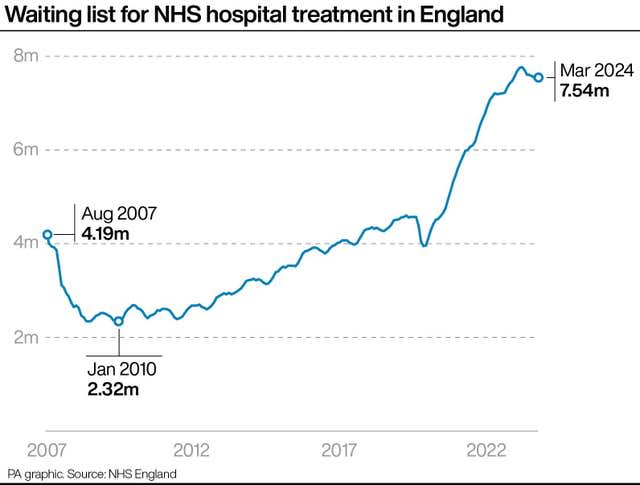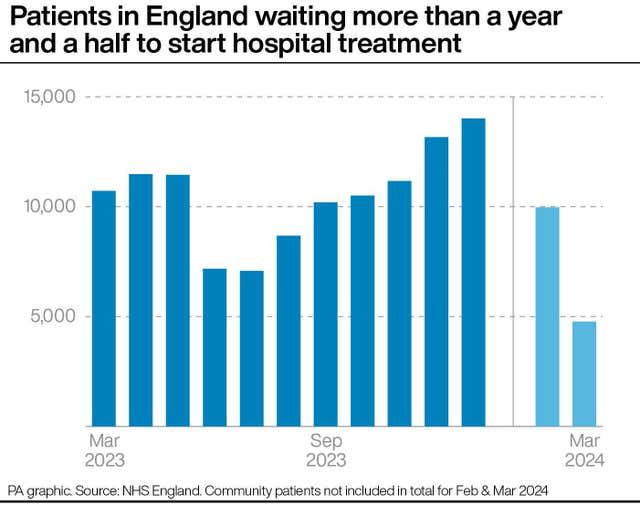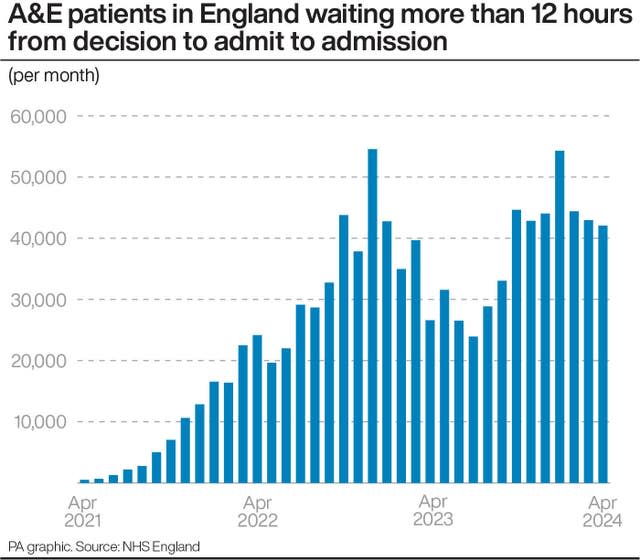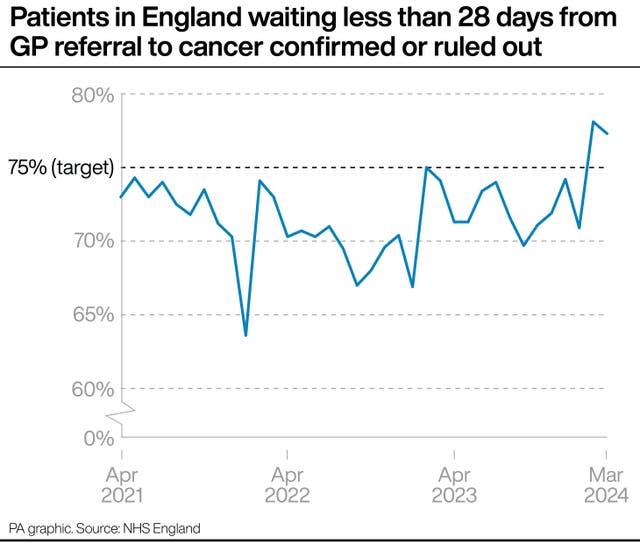NHS waiting list for treatment remains ‘stubbornly high’ – experts
The NHS waiting list for treatment remains “stubbornly high”, with millions of people left in pain or unable to work, analysts have said,
Figures from NHS England show the size of the waiting list for routine hospital treatment in England was unchanged in March, following five consecutive monthly falls.
An estimated 7.54 million treatments were waiting to be carried out at the end of March, relating to 6.29 million patients, the same numbers as in February.

The list hit a record high in September 2023 with 7.77 million treatments and 6.50 million patients.
Other data published on Thursday shows a mixed picture, with success in the number of people seen for a cancer diagnosis, but waits of over a year for treatment rising.
Siva Anandaciva, chief analyst at the King’s Fund, said: “As the NHS comes out of a tough winter, it is encouraging to see some green shoots in today’s statistics which show that improvements have been made in several key measures of cancer care.
“In March, 77% of people had their cancer diagnosed or ruled out within 28 days of referral, surpassing the national target of 75%.
“But the road ahead to make further progress in recovering performance in other areas of the NHS, including reducing lengthy waiting times for planned care and A&E, will be long.
“The hospital waiting list remains stubbornly high at 7.5 million in March, representing 6.3 million people waiting, often in pain or unable to work, for treatment.

“A&E departments also continue to be under extreme strain as we head towards summer, with over 2.2 million attendances in April, and only 74% of people being seen within four hours.”
Mr Anandaciva said it was “patients and staff who are bearing the brunt of the deterioration in NHS performance over the past 10 years”, adding: “Successive governments have failed to invest in services to keep people well and outside of hospital.
“At the same time, NHS buildings and equipment have been allowed to degrade and become dilapidated.
“The Government will need to prioritise both of these areas if it wants patients to receive the urgent and emergency care they truly need.”
Thursday’s data showed the proportion of patients in England waiting no longer than 62 days in March from an urgent suspected cancer referral or consultant upgrade to their first definitive treatment for cancer was 68.7%, up from 63.9% in February. The target is 85%.
GPs in England made 254,594 urgent cancer referrals in March, up slightly from 253,025 in February but down year on year from 260,560 in March 2023.
Health and Social Care Secretary, Victoria Atkins said: “NHS staff are working tirelessly to cut the waiting list and today’s data shows the biggest six-month reduction in over 10 years outside of the pandemic.
“This is a significant achievement in the context of record pressures and strikes, with NHS analysis showing the list could have fallen by an extra 430,000 since December 2022 without industrial action.
“We’ve also delivered on our target of ensuring over 75% of patients tested for cancer receive a diagnosis or all clear within 28 days of referral – giving patients the all-clear or a diagnosis sooner.”
When it comes to long waits, the figures showed 309,300 people in England had been waiting more than 52 weeks to start routine hospital treatment at the end of March, up from 305,050 at the end of February.
The Government and NHS England have set the ambition of eliminating all waits of more than a year by March 2025.
There were 48,968 patients who had been waiting more than 65 weeks to start treatment at the end of March, down from 75,004 in February.

The target to eliminate all waits of over 65 weeks has now been moved to September 2024, having previously been March 2024.
Shadow Health Secretary, Wes Streeting, said: “The Conservatives have failed to meet their pledge to end waits of more than 65 weeks and waiting lists are not falling.
“Rishi Sunak has broken every pledge he’s ever made on the NHS, causing patients to wait for months in pain and discomfort as a result. The crisis in the NHS will only get worse if the Conservatives are given another five years.
“Only Labour has a plan to rescue the NHS from this crisis and get it back on its feet.
“We will deliver two million more appointments a year at evenings and weekends, paid for by clamping down on tax dodging, so patients are seen on time again.”
Liberal Democrat health and social care spokesperson, Daisy Cooper, said: “Rishi Sunak would be utterly deluded to think that this is a NHS in recovery.

“Far too many are still waiting in pain, not knowing if they will get the treatment they need in time.
“It is an unacceptable situation and one for which this Conservative Government should take full responsibility.”
Sir Julian Hartley, chief executive at NHS Providers, welcomed the fact trusts have met the 28-day target for cancer diagnosis two months in a row, saying “this progress is no mean feat given current challenges”.
He added: “It’s deeply concerning, though, that the elective waiting list remains stubbornly high. No patient should ever have to wait too long for the care they need.”
NHS national medical director, Professor Sir Stephen Powis, said: “Today’s figures show just how hard NHS staff are working to deliver the best possible care for patients, despite ongoing significant demand and a difficult recovery journey.
“It is particularly encouraging to see we have met the 28 day faster diagnosis target for cancer for the second month in a row, making sure people receive a definitive diagnosis or the all clear within four weeks, which we know is really important for patients.
“Improvements in urgent and emergency care continue, with ambulances responding to emergency calls faster, and more people being seen within four hours in A&Es despite a record April for attendances and admissions.”
Nearly 43,000 incidences of people waiting for treatment are likely to have been excluded from the waiting list figures for March, including some of the patients who have been waiting the longest.
This is because of a change in the way the figures are reported, with treatments by community services no longer included in the data.
Community services cover treatments and procedures that are delivered mainly in people’s homes, as well as care homes, clinics, schools other care facilities and community hospitals.


